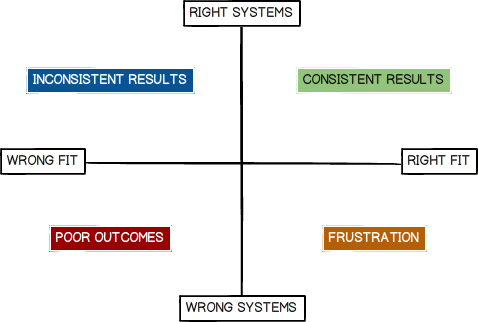The Matrix of Church AVL Systems
 There are many A/V/L systems in place at churches of every size, location and style. Many are there because they were the lowest bid price point; others are stitched together over time, mostly borne out of necessity — and yet others are in place because an integrator specified what worked in other churches. Finally, there are those A/V/L systems that are well designed for the venue, the needs of the church, and perhaps most importantly, the culture of the church. This can be visualized in a four-quadrant matrix. The diagram below illustrates the how this the matrix of church A/V/L systems works:
There are many A/V/L systems in place at churches of every size, location and style. Many are there because they were the lowest bid price point; others are stitched together over time, mostly borne out of necessity — and yet others are in place because an integrator specified what worked in other churches. Finally, there are those A/V/L systems that are well designed for the venue, the needs of the church, and perhaps most importantly, the culture of the church. This can be visualized in a four-quadrant matrix. The diagram below illustrates the how this the matrix of church A/V/L systems works:

For this matrix, I define “systems” as the integrated A/V/L equipment; the “fit” is a combination of the church’s needs and culture. There are four outcomes based on how this matrix plays out:
1) Client-focused: Right Fit + Right Systems = Consistent Results
2) Wants-focused: Right Fit + Wrong Systems = Frustration
3) Technology-focused: Wrong Fit + Right Systems = Inconsistent Results
4) Price-focused: Wrong Fit + Wrong Systems = Poor Outcomes
Price Focused
No doubt your firm has been in the situation where a church client came to you with a pre-determined budget number that had no bearing on the venue or the desired performance. As happens in every vertical market when a bureaucrat number-cruncher sets a budget limit without first considering and consulting with others on a realistic scope of work, churches that toss out a paltry financial allocation will almost always end up with something that cannot possibly meet realistic requirements and saddle their tech staff and volunteers with a no-win scenario. This all but guarantees a poor outcome.
But, what to do? I, too, have been on the systems integrator and consultant side of this discussion, when it becomes clear that the cash allocation is woefully insufficient for the venue, much less the specific goals of the church from a technical standpoint. I pulled from my own church staff experience to help in these situations, understanding the never-ending demand for finances from each of the ministries within the organization asking for funds to accomplish their own goals. By re-framing the conversation around expectations and priorities, I was often able to help define a simple scope with reasonable minimum calculations for the technology required to achieve the scope.
All too often, the pressure is on the salesperson to hit their quote and push for a sale that “value engineers” (a horrible euphemism that has nothing to do with value or engineering) the technology to meet the sparse financial allocation. I can’t count how many times I would run into one of these churches a year (or less) down the road who were looking to “fix” their system. Invariably, I’d be told how the system integrator put in a system that didn’t work well, only to find out that the church had been price-focused and their A/V/L dealer didn’t have the pluck to either walk away or define a realistic scope and budget.
When price is the focus, everyone loses. Reframe the conversation.
Technology Focused
We almost expect manufacturers to be biased in this way, as their goal is to create technology they think is great and will serve markets well. But when a church technical director comes back with stars in her eyes after attending a trade show, the next-big-thing in technology is sure to be on their wish list or even on the next purchase order. Even more likely is what happens after the same tech director visits a larger church that has equipment installed to fit their venue, context, and culture and then wants what they big boys have.
It’s not too terribly often that one particular tool is a quantum leap beyond the competition (at least not without astronomical price differences), so this obsessive focus on technology can blind the church buyer from making the best decisions for their own venue, context, and team culture. I can buy top-of-the-line equipment and it will work in venues that need 1/100th of the features and power. It’s not about if it’s enough technology, but if it’s too much technology.
This may sound strange, but I think the systems integrator needs to see the value in helping the church see the real value of technology within those three parameters. Their venue is unique in some way. Which technology will be the right fit? Their context is important. Which technologies will work they way they do and achieve the results they really need? Their team culture is incredibly unique. Who will be operating this technology and who will be performing on or through this technology? These questions ground the conversation on a realistic, level playing field and help to both ensure the church gets what they need and reinforces the value of an honest integrator.
Wants Focused
The opposite of being technology focused is when the clients wants trump necessary performance. If the venue, context, and culture are all identified well and understood by the church, then it’s generally easier to define a very specific scope of work that ensures their objective is defined and goals are established.
Where things get tripped up is when the expectations are only defined around minimum viability. The reality is that what a client wants on day one is not what they will expect 90 days later. Planning for expansion, adding in options for phased in technology, and listing what’s not included in the scope are helpful for church buyers to see in print so they understand and can sign off on both their minimum expectations and future needs.
Client Focused
When a manufacturer has done a good job of educating the church buyer and the systems integrator has taken the time to understand and define the venue, context, and team culture of the church, a win-win-win is likely. The combination of right systems and right fit are aligned, allowing for the greatest opportunity for immediate success and long-term satisfaction (which leads to referrals).
Does your sales process include a needs analysis to define the one-sentence objective and the stated goals of church leadership? Does your website offer a way to existing clients to provide feedback that is accessible by product engineers? Do your salespeople understand how to ask questions that determine the team culture before recommending complex technology solutions?
Churches are increasingly staffed by tech directors with professional experience, but their knowledge needs to be honed and the conversations still need to be had in order to properly qualify your clients.
What is your organization doing to address the right systems and the right fit for the house of worship market?
Share your comments below.





